Norepinephrine, also called noradrenaline, is a catecholamine that acts as both a hormone and neurotransmitter.
What is Norepinephrine?
Norepinephrine is a strong vasoconstrictor frequently used to treat severe hypotension by increasing systemic vascular resistance and blood pressure.
Structurally, norepinephrine is quite similar to epinephrine, another catecholamine, except that a methyl group in epinephrine is replaced by a hydrogen atom in norepinephrine.
Both of these catecholamines bind to adrenergic receptors and participate in the fight-or-flight response.

How is Norepinephrine Synthesized?
Norepinephrine is synthesized from the amino acid tyrosine in the adrenal medulla and postganglionic neurons of the sympathetic nervous system. A series of enzymatic reactions are involved.
Firstly, tyrosine is converted into dihydroxyphenylalanine (L-DOPA) by tyrosine hydroxylase.
Secondly, L-DOPA is converted into dopamine by pyridoxal phosphate and DOPA decarboxylase.
Lastly, dopamine is converted into norepinephrine by dopamine beta hydroxylase.
After synthesis, norepinephrine is stored in the synaptic vesicles. Vesicular monoamine transporter (VMAT) protein is responsible for transporting norepinephrine into synaptic vesicles.
In the brainstem, the locus coeruleus is the primary site of norepinephrine synthesis. Noradrenergic neurons are projected bilaterally from this nucleus to several brain areas, including the cerebral cortex, limbic system, and spinal cord.
Norepinephrine released from these neurons is involved in alertness, arousal, and reward-related behaviors.
How Does Norepinephrine Work?
The release of norepinephrine from the synaptic vesicles is regulated by both stimulatory and inhibitory substances, including presynaptic α-adrenergic and β-adrenergic receptors. After release, norepinephrine binds to adrenergic receptors on target cells.
Norepinephrine-mediated signal transduction and ultimate cellular function depend on which type of receptor (α-adrenergic or β-adrenergic receptor) it binds. After execution of the work, the signal is terminated by cellular uptake and degradation of norepinephrine.
Norepinephrine is transported back into the cytosol of the presynaptic neuron (uptake 1) or a nearby non-neuronal cell (uptake 2). Norepinephrine is also transported from the cytosol into the synaptic vesicle (vesicular uptake).
After uptake, norepinephrine is rapidly degraded to various metabolites, including normetanephrine, dihydroxymandelic acid, vanilmandelate, and epinephrine. Most of these metabolites are excreted through urine.
What are Some Important Functions of Norepinephrine?
When released from the adrenal medulla into blood circulation, norepinephrine functions as a hormone. When released from noradrenergic neurons, in the central and sympathetic nervous systems, norepinephrine acts as a neurotransmitter.
Norepinephrine, when used as a medication, increases vascular tone and blood pressure through α-adrenergic receptors. The resultant increase in vascular resistance initiates a negative feedback mechanism, which in turn decreases heart rate and blood pressure (baroreceptor reflex).
Norepinephrine plays an important role in regulating conditioned and unconditioned fear-related responses. In response to stress, norepinephrine is involved in the fight-or-flight response of the sympathetic nervous system. This response is characterized by pupil dilation, elevated heart rate and blood pressure, increased sweating, release of glucose from stored energy, and increased blood flow to skeletal muscles.
Additionally, norepinephrine plays a crucial role in regulating attention and concentration. Most psychostimulants used to treat attention-deficit hyperactivity disorder increase central nervous system levels of norepinephrine and dopamine.
Norepinephrine has a higher affinity for α-adrenergic receptors than β-adrenergic receptors. Thus, it produces a powerful vasoconstriction effect. However, it is also a less potent inotropic and chronotropic agent. The main hemodynamic function of norepinephrine is to increase systolic, diastolic, and pulse pressures. However, it has a minimal effect on cardiac output and heart rate. In ischemic heart disease, norepinephrine is used to maintain coronary perfusion pressure without increasing heart rate and cardiac output. Norepinephrine can also be used to preserve blood pressure and maintain organ perfusion in cases of shock due to vasodilation (eg, septic shock and neurogenic shock).
Sources
- https://www.caam.rice.edu/~cox/wrap/norepinephrine.pdf
- www.sciencedirect.com/…/norepinephrine
- https://www.sciencedaily.com/terms/sympathetic_nervous_system.htm
- https://www.ncbi.nlm.nih.gov/pmc/articles/PMC3997042/
- https://www.cardiosmart.org/Healthwise/d003/23/d00323
Further Reading
- All Norepinephrine Content
- Norepinephrine and Mental Health
Last Updated: Jan 14, 2019

Written by
Dr. Sanchari Sinha Dutta
Dr. Sanchari Sinha Dutta is a science communicator who believes in spreading the power of science in every corner of the world. She has a Bachelor of Science (B.Sc.) degree and a Master's of Science (M.Sc.) in biology and human physiology. Following her Master's degree, Sanchari went on to study a Ph.D. in human physiology. She has authored more than 10 original research articles, all of which have been published in world renowned international journals.
Source: Read Full Article
